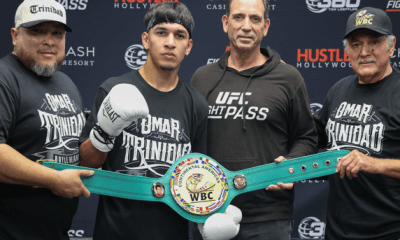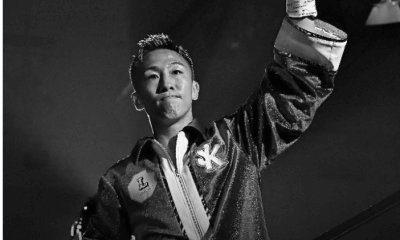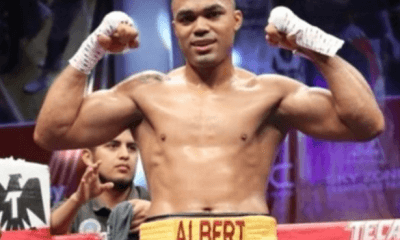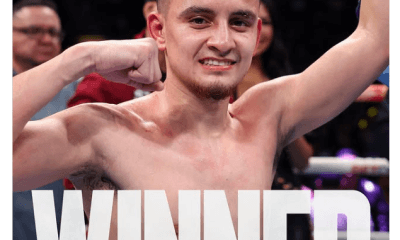Featured Articles
Ending a Boxing Career the Right Way: The Bookend Battalion
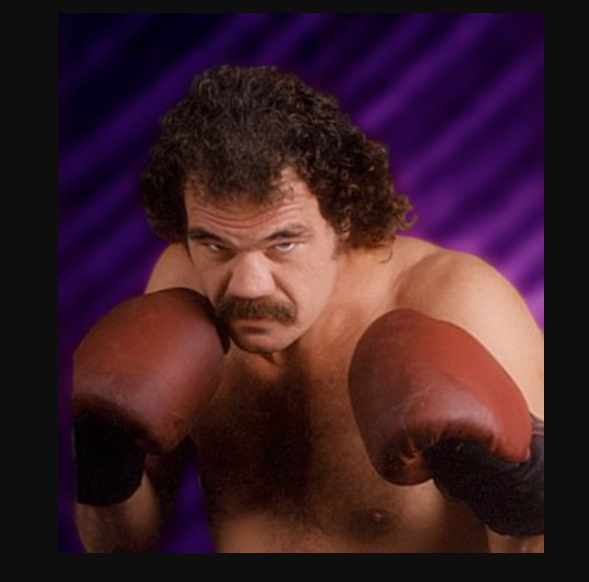
Most boxing careers reflect a variation of a bell-shaped curve. The downward slope on the right-hand side indicates the decline of the fighter in question. Sometimes, when a fighter is at the top of his game—like Larry Holmes, for example– the peak flattens and doesn’t spiral down. And often, a fighter might make a successful final run but lose his last career bout like Tony Bellew who won 10 straight before being waxed by Oleksandr Usyk. Lonnie Smith won 14 straight against horrible competition before stepping up and losing to Disobelys Hurtado in his last tiff. These somewhat predictable patterns are part of what makes up boxing.
The number of fighters who begin and finish on the upswing are much fewer. Here are a few:
Tony Alongi (1959-1967)
This under-the-radar and tough heavyweight was a fixture at the Auditorium in Miami Beach during the 60s and was 28-0 before being upset by Rudolfo Diaz in 1962. Tony lost again in1963—this time to Billy Daniels and then went on a final tear going 11-0-4. The draws were to George Chuvalo, Jerry Quarry (twice), and Bill McMurray. Tony bookended his admirable career nicely to finish 40-2-4.
Eder Jofre (1957-1976)
One fighter who epitomized perfect bookends was the legendary Brazilian “O Galo Do Ouro” (aka “Golden Bantam”) Eder Jofre who ended his magnificent career with a 72-2-4 record. During a two-year period in the mid-60s, Jofre lost twice to Fighting Harrada and drew with one Manny Elias. He was 47-0-3 coming into the first Harrada affair and 25-2-1 thereafter. The Golden Bantam was one of the very best pound-for-pound fighters of all time
Bobby Chacon (1972-1988)
Known as “The Schoolboy,” Bobby was 19-0 before being stopped by the legendary Ruben Olivares. After losing to Cornelius Boza-Edwards in a 1981 thriller, Chacon ended his illustrious run going 14-1 against strong opposition. His overall 59-7-1 record landed him in the International Boxing Hall of Fame (IBHOF).
“Tex” Cobb (1977-1993)
Randall “Tex” Cobb finished his career with a 42-7-1 mark facing off with some tough hombres along the way including Earnie Shavers, Ken Norton, Michael Dokes (twice), Larry Holmes, Buster Douglas, and Eddie Gregg He lost four between 1964 and 1985, but he won his first 17—all but one by stoppage.
After being taken apart by unheralded Collier in 1986, Tex closed out his colorful career by going18-0-1-1 including a win over a faded Leon Spinks in 1988. The other wins were over limited opposition but wins are wins.
Mickey Goodwin (1977-1994)
This left-hook artist out of Kronk was 33-1-1 when he suffered a monster stoppage upset in 1985 at the hands of Darryl “The Atomic Dog” Spain (6-6 at the time). The late and beloved Goodwin — sometimes known as ”Sneaky Pea” — then reeled off seven straight to close out at 40-2-1.
“It’s a shame that Mickey’s name will never carry the same weight as Tommy Hearns. But once upon a time, they were literally equals. I remember it well.” Karl Ziomek
Steve Collins (1986-1997)
The “Celtic Warrior” started fast winning 16 in a row before losing to Mike McCallum in 1960. He lost two more in 1992 but then, fighting mostly out of his native Ireland, he finished by winning 15 including nods over Chris Eubank (twice) and Nigel Benn (twice). Given his record of 36-3 and the off-the-wall level of his opposition, it’s a mystery why he is not in the IBHOF.
Billy Costello (1979-1999)
This Kingston, NY native was victorious in his first 30 outings before being shocked and destroyed by Lonnie Smith in 1985. Alexis Arguello would then stop Billy six months later. Costello regrouped and won his final eight including big one against Juan LaPorte in 1999 bringing his final slate to 40-2.
Jorge Paez (1984-2003)
“El Maromero” had an old school record of 79-14-5 and after his last career loss in 1999 to Jose Luis Castillo, he launched an undefeated streak of 18. Prior to his first defeat on U.S. soil to Tony Lopez, he had gone 35-2-3. “The Clown” won in streaks and was very underrated.
Fabrice Tiozzo (1988-2006)
In a 48-2 career, this outstanding French light heavy lost only two bouts –both to Virgil Hill. One in 1993, the other in 2000. He was 25-0 coming into the first fight, and finished his slate at 23-1 for almost perfect bookends. He also fought extremely tough competition which begs the question of why he isn’t in the IBHOF.
Rodney Toney (1992-2007)
“The Punisher,” a boxer-puncher type, hit the pros running and went 19-0-2 before being derailed by slick Quincy Taylor in 1995. After dropping three between 1996-1997, he bookended his career nicely by going undefeated in his final eight.
Michael Moorer (1988-2008)
Moorer finished with a possibly Hall of Fame-beckoning record of 52-4-1. He won his first 35 matches against solid opposition but came a cropper against Big George Foreman in 1994. After being embarrassed in 30 seconds by David Tua in 2002, “Double M” went 9-1 including a rousing upset stoppage over Vassiliy Jirov in 2004.
Herbie Hide (1989-2010)
“The Dancing Destroyer” lost four by stoppage between 1995 and 2004 and then retired. Hide had won his first 25—most by KO. He then returned to action in 2006 and proceeded to run off 14 straight wins to finish with a fine 49-4 record—one that was well bookended.
Vitali Klitschko (1996-2012)
“Dr. Ironfist” was 27-0 when he lost his first one in a major upset to Chris Byrd in 2000. Upon losing to Lennox Lewis in a bloodbath in 2003, the Doctor clubbed and bludgeoned his way to several big wins before retiring in 2004. In October 2008, Klitschko made one of the most remarkable comebacks in boxing history when he TKOd a prime Sam Peter (30-1). He then won nine more against stiff opposition to finish with a Hall of Fame record of 45-2 and a KO percentage of 87.23%
Jermain Taylor (2001-2014)
The highly touted Taylor started his boxing career 27-0-1 before losing back-to-back fights to Kelly Pavlik in 2007 and 2008. He was then savaged by Carl Froch and Arthur Abraham in 2009 during the Super Six Tourney and took two years off to regain his health before returning to the ring to beat Jessie Nicklow in 2011. By then, he was badly damaged goods, but he still managed to win four more and in his very last fight and against all odds, he beat Sam Soliman (44-11) to win the IBF World Middleweight Title after which he lapsed back into serious outside-the-ring issues.
“The downward spiral of a former champion is one of the hardest things to witness, especially when it is a former Olympian and undisputed middleweight champion.” Jules Philippe-Auguste
Shannon Briggs (1992-2016)
“The Cannon” got out of the gate fast winning his first 25 before getting damaged by Darrol “Doin’ Damage” Wilson in 1996. In 2010, in Hamburg, Germany, he was damaged for real (and hospitalized) by Vitali Klitschko. He stayed away from boxing until 2014 when he launched his final winning streak of nine. It came against less-than-compelling opposition, but did give him a fine final mark of 60-6-1.
There are others with similarly interesting records to peruse but they didn’t make the cut. Johnny “The Entertainer” Nelson came close as he finished with an undefeated streak of 21 but his start was abysmal. Bash Ali finished with 20 wins but again his start left something to be desired. Willie de Wit (20-1-1) came close and so did Oleg Maskaev and Sung Kil Moon.
“Canelo” is a work in progress with 42-0-1 in the front and 10-1-1 in the rear.
There are others. Can you name some?
Ted Sares can be reached at tedsares@roadrunner.com
Check out more boxing news on video at The Boxing Channel
To comment on this story in The Fight Forum CLICK HERE
-

 Featured Articles3 weeks ago
Featured Articles3 weeks agoThe Hauser Report: Zayas-Garcia, Pacquiao, Usyk, and the NYSAC
-

 Featured Articles2 weeks ago
Featured Articles2 weeks agoOscar Duarte and Regis Prograis Prevail on an Action-Packed Fight Card in Chicago
-

 Featured Articles1 week ago
Featured Articles1 week agoThe Hauser Report: Cinematic and Literary Notes
-

 Book Review4 days ago
Book Review4 days agoMark Kriegel’s New Book About Mike Tyson is a Must-Read
-

 Featured Articles4 weeks ago
Featured Articles4 weeks agoManny Pacquiao and Mario Barrios Fight to a Draw; Fundora stops Tim Tszyu
-

 Featured Articles4 weeks ago
Featured Articles4 weeks agoArne’s Almanac: Pacquiao-Barrios Redux
-

 Featured Articles3 weeks ago
Featured Articles3 weeks agoRemembering Dwight Muhammad Qawi (1953-2025) and his Triumphant Return to Prison
-
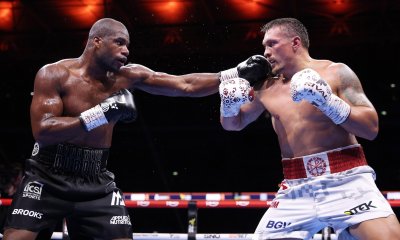
 Featured Articles4 weeks ago
Featured Articles4 weeks agoOleksandr Usyk Continues to Amaze; KOs Daniel Dubois in 5 One-Sided Rounds


